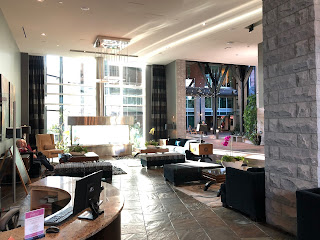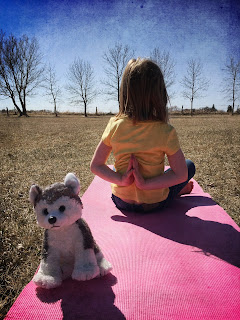First of all...what is project-based learning? This video has been around for quite a few years, but it was developed by the Buck Institute for Education (an excellent resource for K-12 teachers implementing project-based learning) and does a nice job of explaining the approach. In my own experience, I have found project-based learning to be a cyclical approach that uses student interests and real-world issues and problems as the curriculum of the classroom. Usually, project-based learning is interdisciplinary and facilitated (rather than led) by the teacher, who teaches relevant mini-lessons and weaves in curricular outcomes to move the learning projects forward. Sometimes, project-based learning is collaborative as partnerships are formed with other classrooms and organizations. A few examples from my classroom practice are detailed here:
Walking for Polar Bears
MakerFaire and Yoga Festival
Love Family Adoption Party
Reindeer Rescue
Baby Love Baby Shower
National Sweater Day
Connected Wellness Global Yoga Challenge
What does the research say?
-project-based learning has been defined as an active, child-centred teaching and learning approach that uses student interests as the impetus for building knowledge and implementing authentic learning in real world settings (Kokotsaki, Menzies, & Wiggins, 2016).
-a project-based curriculum “promotes
children's intellectual development by engaging their minds in observation and
investigation of selected aspects of their experience and environment” (Katz
& Chard, 2000, p. 2).
-project-based learning is not an extra
activity in the classroom; instead it is the curriculum itself, integrating
provincial outcomes and fostering literacy and numeracy (Bell, 2010).
-children build subject area knowledge and
collaborative skills while displaying motivation and positive peer relations
(Kaldi, Filippatou, and
Govaris,
2011).
-educators should challenge young children
to solve real-world problems to spark creativity and innovation (Pramling
Samuelsson, 2011).
What numeracy skills may be developed through project-based learning?
Researchers have highlighted the importance of young children becoming proficient in subitizing (ability to recognize small exact quantities), comparison of the sizes of numbers, estimation, where numbers fit on a number line, and procedural and conceptual counting (Martin, Cirino, Sharp, & Barnes, 2014; Whyte & Bull, 2008). The specific numeracy skills that arise out of project-based learning may vary depending on the learning project. However, I have found that the numeracy skills identified by researchers occur in nearly every project-based learning opportunity in my early years classroom. Depending on the project and the learning needs of my students, I may choose to focus more strongly on certain numeracy skills. For example, if my Kindergarten students are struggling with teen numbers, I may spend a few days teaching mini-lessons and really examining and using teen numbers within the context of the project topic. Here are some examples from project-based learning experiences undertaken in my classroom and in collaboration with my teaching partner and friend Leah Obach.
Counting
In every learning project, counting happens on a daily basis. We count objects, people, votes/survey results, money, and materials. We have many opportunities to match one-to-one as we count and compare quantities. We count by ones, forwards and backwards, and sometimes we need to skip count. What I believe is most important is that we are counting for a real purpose and the success of our project is linked to our ability to count accurately and quickly.
 |
| Visuals on the interactive whiteboard and base ten blocks can help young children count larger quantities of money. |
There are many opportunities to use addition, subtraction, multiplication, and division to solve problems key to the success of the learning project. When working with larger numbers, tools such as hundred charts, Power of Ten cards, and base ten blocks are invaluable supports in solving these problems.
 |
| Students used large ten frames to investigate teen numbers and adding ten as they counted cups for hot chocolate for our National Sweater Day project.
Printing Numerals
Throughout our learning projects, we are frequently required to print numerals for a variety of tasks. A sense of urgency is created as students are faced with recording numerals to keep track of results, recording and sharing new facts they have discovered, and creating and labelling materials. Suddenly it matters that they can print numbers quickly and correctly.
This student printed numbers to record how many students were in each class as his class prepared to hand out flyers advertsing a Timbits and white ribbon sale to support polar bears. Students printed more numbers as they labelled the notes for each classroom.
Students reviewed their guest list for their MakerFaire and yoga festival, using tally marks to determine how many invitations would be delivered by mail, division mail, by hand, and email.
Working with Data and Making Data-Informed Decisions
When students are deciding how they will tackle an issue or how they will work to make a difference, differing opinions are often raised in the classroom. Votes and surveys are essential for making fair decisions that reflect what the majority of students would like to do. Additionally, we have polled our school and local community to determine the most popular cookies and beverages when planning events and sales. Students have been excited to personally survey people in our school and to work with me to create online surveys using Microsoft Forms or Survey Monkey. The results from our surveys have allowed us to move forward in our projects and base our decisions on real data, not just on our opinions and personal preferences.
We used Survey Monkey to find out how much people would be willing to pay for greeting cards that we created with our Instagram photographs. This project arose out of the students' interest in creating, editing, and captioning beautiful images for Instagram and a desire to support the new early learning centre that some of them and their siblings attended.
Estimation
Sometimes using an estimation jar gets old and lacks authenticity. Through learning experiences such as these ones, we have opportunities to develop important estimation skills to move forward with our projects.
After experimenting with the capacity of glasses and jugs, we estimated how many glasses we would get from one batch of homemade iced tea.
We estimated how many cookies would fit on a plate for our bake sale. We sold homemade iced tea and cookies to raise money for sick kids and the endangered Oregon spotted frog.
Measurement
Depending on what the project calls for, we usually have opportunities to measure objects and physical spaces. In keeping with curricular outcomes, we usually rely on non-standard measurement. Occasionally, it is necessary to use standard units when comparing distances and mass.
We planned and hosted a yoga festival for Internatonal Day of Yoga. It was important to plan how we would design the physical layout of the space in the gym. We used steps to measure the length and width of the gym, then created a sort-of-to-scale map on the SMART Board.
We decided to hold a Timbits and white ribbon sale to raise awareness and funds for how climate change affects polar bears. We made the perfect white ribbon pin, then measured it with cubes. We used cubes to measure 100 lengths of ribbon--lots of great lessons about measuring accurately!
Final Thoughts
Implementing project-based learning in your early years classroom will provide many opportunities for developing numeracy skills in authentic, real-world contexts. This pedagogical approach creates an urgency for counting, comparing quantities, representing numbers, solving problems, estimating, and measuring--students begin to understand why these skills are important and how they are used in the real world.
Keep your eye on the curriculum. It is crucial that the teacher has a strong understanding of the provincial curriculum and acts as a facilitator to connect the students' interests with learning outcomes. Based on observation and the demands of the project, the teacher must provide timely mini-lessons to support students as they build knowledge and develop and apply solutions. It's all about the teachable moment...be prepared to go where students lead you and don't worry if the skill they need to develop (or at least develop familiarity with) isn't in the curriculum until Grades 3 or 4. Exposure won't hurt your students, and some will get a lot out of it. Additionally, it is important for the teacher to be mindful of what outcomes have been addressed through project-based learning and what outcomes need to be developed in future learning experiences.
Don't try to fit a square peg in a round hole. Not all project-based learning experiences will teach all numeracy outcomes, so don't try to force it. Embrace what works naturally with the project, spend more time on the skills that need to be strengthened in your students, and develop other skills in future projects or lessons.
Document and share learning. During project-based learning, I constantly capture our learning through photographs, videos, and voice notes that are organized in Microsoft OneNote in a section for each child. This evidence allows me to determine if students are meeting learning outcomes and provides valuable information for reporting. For content that I'd like to share with parents, I upload images, videos, and work samples to Seesaw and our classroom Facebook page. Sharing student learning with families allows them to see how their children are developing important numeracy skills through project-based learning.
And remember...project-based learning isn't "dessert". Don't wait until the end of the year when the curriculum has been "covered" to implement project-based learning. This pedagogical approach isn't an add-on, an extra, or a reward for completing traditional learning activities. Instead it is an important vehicle for capitalizing on student interests, engaging students in hands-on, real world learning, and developing important numeracy skills.
Presentation slides and references available here.
|








































